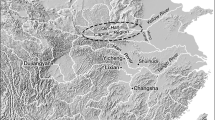Abstract
The sequence of 12 woodblock maps presented here from the mid-nineteenth-century gazetteer for the department of Dengchuan in southwest China shows the Miju river and the irrigation system that lay at the heart of its farming economy. The incorporation into the cartography of much of the administrative detail related to the compulsory mobilization of labour for the annual clearance of mud makes it unusual among Chinese maps depicting water control in this period. The clarity with which it shows the recent formation of a long, spit-like delta of deposited sediment protruding into the Erhai, the large mountain lake into which the river empties, also assists the dating and analysis of the environmental crisis that occasioned it. During the late seventeenth century, and much of the eighteenth, the pressure of population caused the opening for cultivation of the unstable mountain soils on the slopes of the catchment just upstream of the section depicted by the maps. The result was a massive increase in the river’s load of sediment. The dykes of its downstream bed rose to a level above the surrounding farmland. The increased need for maintenance led to the restructuring of parts of the system of government, and the lives of the local people, so as to handle the new problems. We have found that the accuracy of the maps was adequate for planning and executing middle-sized water control projects at the technical level of that time.





Similar content being viewed by others
Notes
Perhaps with the function of facilitating the seasonal equine transit to the horse fair at Eryuan upstream.
A venerable Chinese literary cliché for any reversal of a situation.
References
Elvin M (1968) The gentry democracy in Shanghai, 1905–1914. Ph.D. dissertation, open access, Clare Hall, Cambridge University, pp 29–32
Elvin M (2005) ‘L’histoire exemplaire d’une rivière du Yunnan (XVIIe-XIXe S.)’, Académie des Inscriptions & Belles Lettres, Comptes rendus des séances de l’année 2005, juillet-octobre, III, Paris, Diffusion de Boccard, pp 1041–1059
Elvin M (2009) Nature, technology and organization in late-imperial China. Nova Acta Leopoldina 98(360):145
Elvin M, Crook D (2003) An argument from silence? The implications of Xu Xiake’s description of the Miju river in 1639. In: Yunnan University Research Centre for Chinese Economic History and Yunnan University Department of History (eds) Li Ting jiaoshou jiushi huayan jinian wenji (Collected essays for the ninetieth birthday of Professor Li Ting). Yunnan University Press, Kunming, pp 150–160
Elvin M, Liu T (eds) (1998) Sediments of time. Cambridge chap. 10, Action at a distance the influence of the Yellow River in Hangzhou Bay since AD1000, pp 344–407. See also Figure 10.14 (pp 62–63)
Elvin M, Crook D, Shen J, Jones R, Dearing J (2002) The impact of clearance and irrigation on the environment in the Lake Erhai catchment from the Ninth to the Nineteenth Century. East Asian History 23:46–48
Harley LB, Woodward D (eds) (1994) The history of cartography, vol 2, book 2. Cartography in the traditional East and Southeast Asian societies. University of Chicago Press, pp 151–153
Hou Y (1854) Dengchuan zhou zhi. First publication
Hou Y (comp. and rev. 1968) Dengchuan zhou zhi (Dengchuan department gazetteer) reprinted. Chengwen Publishers, Taibei
Hummel A (ed) (1943) Eminent Chinese of the Ch’ing Period (1644–1912). United States Government Printing Office, Washington, DC, pp 742–745
Morita A (1991) ‘Water control in Zherdong during the Late Ming’, translated by Mark Elvin and Keiko Tamura. East Asian History 2:31–66
Morohashi T (ed) (1966–1988) Dai Kan-Wa Jiten Tokyo, Taishûkan, IV, 4079.4
Naval Intelligence Division (UK) (1945) China proper. Confidential circulation 1939–45 open publication 1945: Volume III, Appendix 5. HMSO, London
Needham J, Ling W (1959) Science and civilisation in China, vol 3, Mathematics and sciences of the heavens and the earth, sect 22: Geography and cartography, Cambridge University Press, p 514
Qiu G (1992) Zhongguo lidai duliangheng kao (Studies on Chinese historical lengths, capacity measures, and weights). Kexue Publishers, Beijing, pp 118–119
Record of River Works (1845)
 , Dengchuan-zhou zhi (Dengchuan Department gazetteer) pp 79–103
, Dengchuan-zhou zhi (Dengchuan Department gazetteer) pp 79–103Shu X et al (eds) (1947) Cihai Encyclopaedia [Sea of Phrases]. Single volume edition. Zhonghua shuju [China Book Company], Shanghai
Vogel HU (no date) The complete map of the Jinshajiang (Jinshajiang quantu). An extraordinary document relating to a River Dredging project in the Chinese Province of Yunnan, 1741–1749. Institute of Chinese Studies, University of Heidelberg
Zhou K, Luo Y (eds) (1975) Langqiong xianzhi (Langqiong [sc. Eryuan] County Gazetteer), 1902, reprint. Chengwen Publishers, Taibei, pp 325–326
Acknowledgments
Special thanks are given to Li Chunhai, a limnologist and historian from the Chinese Academy of Sciences (Nanjing), who located features on the gazetteer maps while in the field in March 2005. Thanks are also given to Joanne Elvy from the University of Hertfordshire for technical help in creating Fig. 15 and Suzanne Yee at the University of Liverpool for creating the colour composite image. We would also like to thank Cambridge University Library for allowing reproduction of: Col. I. Kh. Galyeyev, Director, Kitai/provintsiya Younnan, Sect. 07-47-057: G-47-57. Maps F.022. We should like to thank Mr. Charles Aylmer, the librarian in charge of the Chinese and Japanese collections at the University Library at Cambridge for his kindness in providing crucial last-minute help in accessing and interpreting a passage in the Dengchuan gazetteer. To receive a copy of the translated maps contact d.crook@herts.ac.uk.
Author information
Authors and Affiliations
Corresponding author
Rights and permissions
About this article
Cite this article
Crook, D., Elvin, M. Bureaucratic control of irrigation and labour in late-imperial China: the uses of administrative cartography in the Miju catchment, Yunnan. Water Hist 5, 287–305 (2013). https://doi.org/10.1007/s12685-013-0091-1
Received:
Accepted:
Published:
Issue Date:
DOI: https://doi.org/10.1007/s12685-013-0091-1





 , Dengchuan-zhou zhi (Dengchuan Department gazetteer) pp 79–103
, Dengchuan-zhou zhi (Dengchuan Department gazetteer) pp 79–103